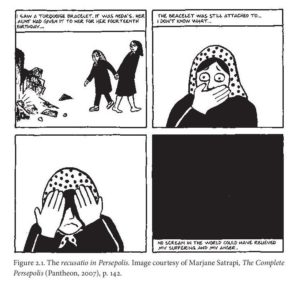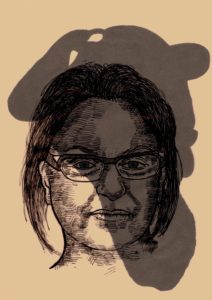Lost Homelands, Imaginary Returns – The Exilic Literature Of Iranian And Iraqi Jews
When I first contemplated my participation in the “Moments of Silence” conference, I wondered to what extent the question of the Arab Jew /Middle Eastern Jew merits a discussion in the context of the Iran- Iraq War. After all, the war took place in an era when the majority of Jews had already departed from both countries, and it would seem of little relevance to their displaced lives. Yet, apart from the war’s direct impact on the lives of some Jews, a number of texts have engaged the war, addressing it from within the authors’ exilic geographies where the war was hardly visible. And, precisely because these texts were written in contexts of official silencing of the Iran-Iraq War, their engagement of the war is quite striking. For displaced authors in the United States, France, and Israel, the Iran-Iraq War became a kind of a return vehicle to lost homelands, allowing them to vicariously be part of the events of a simultaneously intimate and distant geography. Thus, despite their physical absence from Iraq and Iran, authors such as Nissim Rejwan, Sami Michael, Shimon Ballas, and Roya Hakakian actively participate in the multilingual spaces of Iranian and Iraqi exilic literature. Here I will focus on the textual role of war in the representation of multi-faceted identities, themselves shaped by the historical aftermath of wars, encapsulated in memoirs and novels about Iraq and Iran, and written in languages that document new stops and passages in the authors’ itineraries of belonging.
What does it mean, in other words, to write about Iran not in Farsi but in French, especially when the narrative unfolds largely in Iran and not in France? What is the significance of writing a Jewish Iranian memoir, set in Tehran, not in Farsi but in English? What are the implications of writing a novel about Iraq, not in Arabic, but in Hebrew, in relation to events that do not involve Iraqi Jews in Israel but rather take place in Iraq, events spanning the decades after most Jews had already departed en masse? How should we understand the representation of religious/ethnic minorities within the intersecting geographies of Iraq and Iran when the writing is exercised outside of the Iran-Iraq War geography in languages other than Arabic and Farsi? By conveying a sense of fragmentation and dislocation, the linguistic medium itself becomes both metonym and metaphor for a highly fraught relation to national and regional belonging. This chapter, then, concerns the tension, dissonance, and discord embedded in the deployment of a non-national language (Hebrew) and a non-regional language (English or French) to address events and the interlocutions about them that would normally unfold in Farsi and Arabic, but where French, English, and Hebrew stand in, as it were, for those languages. More broadly, the chapter also concerns the submerged connections between Jew and Muslim in and outside of the Middle East, as well as the cross-border “looking relations” between the spaces of the Middle East. Writing under the dystopic sign of war and violent dislocation, this exilic literature performs an exercise in ethnic, religious, and political relationality, pointing to a textual desire pregnant with historical potentialities.
The Linguistic Inscription of Exile
The linguistic medium itself, in these texts, reflexively highlights violent dislocations from the war zone. For the native speakers of Farsi and Arabic the writing in English, French, or Hebrew is itself a mode of exile, this time linguistic. At the same time if English (in the case of Roya Hakakian and Nissim Rejwan), French (Marjane Satrapi), and Hebrew (Sami Michael and Shimon Ballas) have also become their new symbolic home idioms. In these instances, the reader has to imagine the Farsi in and through the English and the French, or the Arabic in and through the Hebrew. Written in the new homeland, in an “alien” language, these memoirs and novels cannot fully escape the intertextual layers bequeathed by the old homeland language, whether through terms for cuisine, clothing, or state laws specifically associated with Iran and Iraq. The new home language, in such instances, becomes a disembodied vehicle where the lexicon of the old home is no longer fluently translated into the language of the new home—as though the linguistic “cover” is lifted. In this sense, the dislocated memoir or novel always-already involves a tension between the diegetic world of the text and the language of an “other” world that mediates the diegetic world.
Such exilic memoirs and novels are embedded in a structural paradox that reflexively evokes the author’s displacement in the wake of war. The dissonance, however, becomes accentuated when the “cover language” belongs to an “enemy country,” i.e., Israel/Hebrew, or United States/English. The untranslated Farsi or Arabic appears in the linguistic zone of English or Hebrew to relate not merely an exilic narrative, but a meta-narrative of exilic literature caught in-between warring geographies.

Figure 2.1. The recusatio in Persepolis. Image courtesy of Marjane Satrapi, The Complete Persepolis (Pantheon, 2007), p. 142.
Roya Hakakian’s Journey from the Land of No: A Girlhood Caught in Revolutionary Iran and Marjane Satrapi’s Persepolis both tell a coming-of-age story set during the period of the Iranian Revolution, partially against the backdrop of the Iran-Iraq War. Written by an Iranian of Muslim background (Satrapi) and by an Iranian of Jewish background (Hakakian), both memoirs are simultaneously marked by traumatic memories as well as by longing for the departed city—Tehran. Although the Jewish theme forms a minor element in Persepolis, Satrapi’s graphic memoir does stage a meaningful moment for the Muslim protagonist in relation to her Jewish friend, Neda Baba-Levy. More specifically, it treats a moment during the Iran-Iraq War when Iraqi scud missiles are raining down on Tehran, and where neighborhood houses are reduced to rubble, including the house of the Baba-Levy family. While forming only a very brief reference in the film adaptation, the chapter in the memoir, entitled “The Shabbat,” occupies a significant place in the narrative. Marjane goes out to shop and hears a falling bomb. She runs back home and sees that the houses at the end of her street are severely damaged. When her mother emerges from their home, Marjane realizes that while her own house is not damaged, Neda’s is. At that moment, Marjane hopes that Neda is not home, but soon she remembers that it is the Shabbat. As her mother pulls Marjane away from the wreckage, she notices Neda’s turquoise bracelet. Throughout her graphic novel, Satrapi does display “graphic” images, showing, for example, the torture of her beloved uncle by the Shah’s agents and then by the Islamicist revolutionaries who later execute him. Here, however, the Neda incident triggers a refusal to show what is being expressed in words. After the destruction, Satrapi writes: “I saw a turquoise bracelet. It was Neda’s. Her aunt had given it to her for her fourteenth birthday. The bracelet was still attached to . . . I do not know what..” The image illustrates the hand of little Marjane covering her mouth. In the next panel, she covers her eyes, but there is no caption. The following final panel has a black image with the caption: “No scream in the world could have relieved my suffering and my anger.”[i]
Of special interest here is precisely the refusal to show, a device referred to in the field of rhetoric as recusatio, i.e., the refusal to speak or mention something while still hinting at it in such a way as to call up the image of exactly what is being denied. In Persepolis it also constitutes the refusal to show something iconically, in a medium—the graphic memoir—essentially premised, by its very definition, on images as well as words. Marjane recognizes the bracelet, but nothing reminiscent of her friend’s hand, while her own hand serves to hide her mouth, muffling a possible scream. In intertextual terms, this image recalls an iconic painting in art history, Edvard Munch’s The Scream.
While the expressionistic painting has the face of a woman taken over by a large screaming mouth, here, Persepolis has the mouth covered; it is a moment of silencing the scream. Satrapi represses—not only visually but also verbally—the words that might provide the context for the image, i.e., what Roland Barthes calls the “anchorage” or the linguistic message or caption that disciplines and channels and the polysemy or “many-meaningedness” of the image.[ii] In this case, the caption also reflects a recusatio, in that no scream could express what she is seeing and feeling. As a result, there is a double silence, the verbal silence and the visual silence implied by the hand on the mouth, and then by the hands on the eyes culminating in the black frame image. The final black panel conveys Marjane’s subjective point of view of not seeing, blinded as it were by the horrifying spectacle of war.
Walking Stories
 Lisa, a fragile Indonesian woman, walked along the paths of Saint Anthony’s park. Saint Anthony is a mental hospital. Lisa was dressed in red, yellow and blue; I was looking at a painting of Mondriaan, of which the colours could cheer someone up on a grey Dutch day. She had put on all her clothes and she carried the rest of her belongings in a grey garbagebag. She looked like she was being hunted, mumbling formulas to avert the evil or the devils. I could not understand her words, but she repeated them with the rustling of her garbage bag on the pebbles of the path.
Lisa, a fragile Indonesian woman, walked along the paths of Saint Anthony’s park. Saint Anthony is a mental hospital. Lisa was dressed in red, yellow and blue; I was looking at a painting of Mondriaan, of which the colours could cheer someone up on a grey Dutch day. She had put on all her clothes and she carried the rest of her belongings in a grey garbagebag. She looked like she was being hunted, mumbling formulas to avert the evil or the devils. I could not understand her words, but she repeated them with the rustling of her garbage bag on the pebbles of the path.
When she arrived at an intersection of two paths where low rose hips were blossoming, she stopped and went into the bushes. She lifted all her skirts and urinated; standing as a colourful flower amidst the green of the bushes and staring into the sky. A passer-by from the village where Saint Anthony’s has its headquarters would probably have pretended not to see her, knowing that Lisa was one of the ‘chronic mental patients’ of the wards. Or, urinating so openly in the park may be experienced as a ‘situational improperty’, but as many villagers told me: ‘They do odd things, but they cannot help it.’ The passer-by would not have known that Lisa was a ‘walking story’, that she had ritualised her walks in order to control the powers that lie beyond her control. Lisa was diagnosed with ‘schizophrenia’ and she suffered from delusions. When she had an acute psychosis, she needed medication to relieve her anxiety. Her personal story was considered as a symptom of her illness. That was, in a nutshell, the story of the psychiatrists of the mental hospital. Her own story was different. Lisa was the queen of the Indies and she had to have offspring to ensure that her dynasty would be preserved. She believed at that day that she was pregnant and that the magicians would come and would take away her unborn baby with a needle. To prevent the abortion, she had to take refuge in the park and carry all her belongings with her.
From A Dysfunctional World Order To A Sustainable Future
In the interview that follows, Richard Falk, an internationally-renowned scholar of Global Politics and International Law, offers his insights on the contemporary state of world politics and shares his radical vision of the future world order. Richard Falk is Alfred G. Milbank Professor Emeritus of International Law and Practice at Princeton University, where he taught for more than forty years, former United Nations Special Rapporteur on Human Rights in Occupied Palestine and Advisor of the POMEAS Project, Istanbul Policy Center, Sabanci University. He has served on scores of Commissions on International Law and Justice and is author and editor of more than fifty books, including (Re)Imagining Humane Global Governance, Palestine: The Legitimacy of Hope and Chaos and Counterrevolution: After the Arab Spring.
C. J. Polychroniou is scholar, author and journalist. He has taught at numerous Universities in Europe and the United States, was founder and director of the now defunct Centre for the Study of Globalization in Athens, Greece, and author and editor of scores of books, academic articles and popular essays. His latest books Optimism Over Despair: On Capitalism, Empire, and Social Change (conversations with Noam Chomsky) and The Political Economy of Climate Change and the Global New Deal (conversations with Noam Chomsky and Robert Pollin; forthcoming).
C. J. Polychroniou: Richard, I want to start this interview on the state of global affairs near the end of the second decade of the 21st century by moving from the abstract to the concrete. To begin with, it’s regarded as axiomatic that the postwar international liberal order is fracturing and that we are at the same time in the midst of a geopolitical transition where the most prominent characteristic seems to be the decline of the United States as a global superpower. With that in mind, can you offer us a panoramic perspective on the contemporary state of global affairs? In that context, what do you consider to be the primary changes under way, and the emerging challenges and threats to global peace and stability?
Richard Falk: There are many crosscutting tendencies now evident at the global level. At the very time when globalizing challenges are intensifying, the mechanisms available for regional and global cooperation are becoming dangerously less effective. The failure to address climate change, so clearly in the global public interest, is emblematic of a dysfunctional world order system. This failure can be further delineated by reference to two distinct, yet interrelated developments. The first characterized by a vacuum in global leadership, which reflects both the overall decline of the United States as well as its explicit renunciation of such a role by the Trump presidency. Trump proudly proclaims that his only political agenda is shaped by American national interests, declaring he was elected president of the United States, and not the world. The second broader development is the rise of autocrats in almost every important sovereign state, whether by popular will or through imposed rule, resulting in the affirmation of an ultra-nationalist approach to foreign policy, given ideological intensity by chauvinistic and ethnic hostility toward migrants and internal minorities. This kind of exclusionary statism contributes to the emergence of what might be called ‘global Trumpism’ further obstructing global problem-solving, shared solutions to common problems. A discernable effect of these two dimensions of world order is to diminish the relevance and authority of the United Nations and international law, as well as a declining respect for standards of international human rights and a disturbing indifference to global warming and other global scale challenges, including to biodiversity and the stability of major global rainforests.
Overall, what has been emerging globally is a reinvigoration of the seventeenth century Westphalian regional system of sovereign states that arose in Europe after more than a century of devastating religious wars, but under vastly different conditions that now pose dire threats to stability of international relations and the wellbeing of peoples throughout the world. Among these differences are the dependence upon responsible internal behavior by states in an era of growing ecological interdependence. The tolerance of fires in the Amazon rainforest by the Brazilian government for the sake of economic growth, via agrobusiness and logging, endangers a vital global source of biodiversity as well as depletes essential carbon capturing capabilities of the vast forest area, yet there is no way under existing international norms to challenge Brazil’s sovereign prerogative to set its own policy agenda, however irresponsible with respect to the ecological future. Read more
Polycracy As An A-System Of Rule? Displacements And Replacements Of The Political In An Unbounded Dictatorship
Abstract
The concept of polycracy is beset by a number of paradoxes: it designates a form of political rule in the absence of such rule. In such circumstances, a
multiplicity of social formations, economic and financial agencies and operational functions install themselves anomically at local level and extend independently of and beyond policy and legislation. In doing so, they split and supplant frameworks of the state and of political and societal institutions. This article sets out to trace the lineages of the concept of polycracy and its instantiations in a system of rule that involves a process of political de-structuring. More specifically, the question explored here is what takes place in the destroyed political space and what takes its place in the unbounded state of the Nazi dictatorship.
Keywords: polycracy; National Socialist totalitarianism; Nazi regime; party–state relationship; occupying regime; Weimar Republic; quantitatively total state
Introduction
Even with historical hindsight, the phenomenon termed “totalitarianism” presents a number of conundrums. To start off with, it resists definition. To describe it as a “system of rule” risks contradiction (see Kershaw 1999, 222), because “a-systematicity” is its most pertinent characteristic. As a particular type of modern dictatorship, it has invited comparisons, yet such comparisons remain limited and general (considering e.g. the limited comparability of the National Socialist regime in Germany and the Stalinist regime in the Soviet Union—see Kershaw 1999). The process of political disintegration described by it is bound to leave the concept under-theorised (see Kershaw 1991, 98) and possibly even to impress itself on the theorist as incomprehensible (see Arendt [1951] 1994, viii), both conceptually and politically. In this article, we propose to put one of the elements specifying “totalitarianism” to the test: Can “polycracy” provide a specifying criterion for the definition of “totalitarianism”? If so, how would it have to be conceptualised in order to be able to account for the simultaneous diffraction and concentration of structures and agencies that reconfigure governance for conditions of geopolitical expansion, invasion, annexation and occupation; total mobilisation for war; and population relocations, forced labour and genocide?
The term “polycracy”, as Walther Hofer points out, is of recent coinage. It designates social and political processes unlike those described by any of the classical theories of political organisation (Hofer 1986, 249; see also Arendt [1951] 1994, 461; also Schmitt 2000, 66) or system or type of rule.
Writing in the aftermath of war and genocide in the late 1940s, Hannah Arendt ventures this description: “We always suspected, but we now know that the [National Socialist] regime was never ‘monolithic’ but ‘consciously constructed around overlapping, duplicating, and parallel functions’ …” (Arendt [1951] 1994, xxxii–xxxiii; also 404 fn. 8).
What she pinpoints here had, in fact, been articulated by Carl Schmitt even before the Second World War in his prescient analyses of the Nazi dictatorship (1933) and by Ernst Fraenkel and Franz Neumann during the course of the War and in its immediate aftermath. The multi-levelled dynamic functioning of the Nazi regime became the subject of further investigation in the 1960s and 70s, first by Klaus Hildebrand, Karl Bracher and Peter Hüttenberger and later by Ian Kershaw. Even as they differed in the details of their analysis, all of these historians and political theorists either explicitly or implicitly returned to Johannes Popitz’s concept of “polycracy”, coined in the late 1920s to take account of the decline of the German state during the late Weimar period.
“Polycracy”—A conceptual–political history
Popitz held on to a substantive universal idea of the state against its devolution and dissolution into concrete orders and functions. In his positions in the Finance Ministry in the latter half of the 1920s, he was intent on clearing up Weimar’s “administrative confusions” (see Kennedy 2004, 147; also Schmitt 2000, 62 fn. 4) and on restoring the authority of a centralised state.
Carl Schmitt’s conversations with Johannes Popitz (the friendship with whom Schmitt only reluctantly admitted to) trace the decline of the state in the Weimar Republic with its proliferation of special interests, political parties and particularist movements. Popitz views this process as the replacement of “the state as the source of order and the locus of authoritative decisions … by the notion of ‘free competition’ and ‘the self-organisation of society’” (see Kennedy 2004, 33). This defines Popitz’s notion of polycracy. “Pressures from within the private sector and the party politics of the Reichstag had created,” he argued in 1927, “a ‘polycratic’ system that displaced parliamentary democratic will formation” (Kennedy 2004, 147). What these “diverse forms of economic organisations and public/private partnerships” had in common was the “fact that they retained a degree of independence from the state” while assuming responsibility for “important public functions” (Kennedy 2004, 142 fn. 3). Read more
Allegories Of Wildness ~ Prologue
 “It is singular to come so far and to see so infinitely little” [i].
“It is singular to come so far and to see so infinitely little” [i].
The above passage is from Robert Louis Stevenson’s diary, which he kept during his sea voyage to Polynesia. The principle behind this quote has some general truth that holds for all voyages. Upon seeing the Polynesian islands, Stevenson was enchanted not just by the landscape, but by the inhabitants as well. He treated the Polynesians with respect and kept an open mind despite their strange practices. Although he denounced cannibalism when he visited the altar on which the native Marquesan people sacrificed prisoners for their own consumption, Stevenson claimed to have felt “infinitely distant”, as “in the cold perspective and dry light of history.” In part because of Western diseases and in part because of the cultural values of European conquerors, the Marquesans gradually abandoned their ceremonies, many of which the colonial government considered repugnant and savage. Stevenson deplored the consequences of contact, a term that the literature uses to describe the interaction between indigenous peoples and outsiders, and went so far as to demonstrate his respect for the imposing cannibal chief. Stevenson even questioned the moral basis for the European rejection of cannibalism; after all, he notes, the slaughter and eating of animals would cause a similar revulsion amongst Buddhists. Stevenson’s strong egalitarian views are evident in his suggestion that “(…) to cut a man’s flesh after he is dead is far less hateful than to oppress him while he lives.”
These observations serve as a reminder of a deplorable and all-to-popular story of the effects of colonialist expansion on all indigenous peoples. Unsurprisingly, the history of Brazil’s Nambikwara is not unique. “History” always engulfs these people and in so doing destroys not only sociocultural and political autonomy, but often much of the population. The name “Nambikwara” evokes such battles, some of which are quite well known. First, there are the ‘indomitable warriors’ that Rondon succeeded in pacifying, despite their initial rejection of civilization and contact. The model of making contact with wild tribes that Rondon established endures even now. Second, there is Lévi-Strauss’ field study as described in Tristes Tropiques, a work that made the Nambikwara one of the most famous tribal peoples in the world. The lasting impact of this book is clear, it continues to be cited in a variety of scientific and non-scientific books and papers. Lastly, there is the prime example of victims of so-called development forcefully promoted by the Brazilian government. Such “progress” typically manifests as road construction and the interference of bureaucratic agencies in a certain region. Many of these projects involve financing from the World Bank. David Price exposes the negative impact of such national and international organizations. He notes a near complete lack of consideration and respect for those “before the bulldozer” suffering the regional consequences of globalization (Price 1977a; 1989). Such peoples, and, in particular, the Nambikwara, were about to be pushed aside in favor of a different civilization. Rondon was a man who believed that he represented this society benevolently. He remarks often on the compassion and kindness of the Nambikwara civilization. Lévi-Strauss, by comparison, wanted to avoid discussing it, even as he treaded through the devastation caused by contact with the Nambikwara. Price (1977) denounced continued contact as being strongly detrimental to the surviving members of what was once a large group of peoples, known for their strength and heartiness.
The goal of this work is to explore relevant aspects of the history and the modern sociocultural situation of three Indian peoples, the Latundê, Sabanê, and Sararé [ii] . The fact that these names are not well known demonstrate the unique fame associated with the Nambikwara. This project involves three case studies of individuals and peoples. Of particular interest are specific historical narrations about contact, the individual pasts of the Indians along with their contemporary situation and their unique modes of interaction with Brazilian society. Note that all three peoples are related not only to one another, but to variety of other peoples and groups. For simplicity, I refer to all these people as members of the Nambikwara language family. A considerable amount of dialects and languages make up this language family. Read more
Allegories Of Wildness ~ Latundê Ethnohistory And Their Contemporary Situation
 First times: another view of Latundê history
First times: another view of Latundê history
The prior history reconstitutes the trajectory of observations, research and intervention materialized in the paperwork of a file generated to constitute a bureaucratic dossier that documents the way to the final legal act of creating an Indigenous Territory in accordance with presidential decree. It becomes obvious that it concerns a legal, bureaucratic, and social fiction that presupposed the recognition of concepts and objects – of people and materials – postulated pre-existing. In effect, the history examined so far grounds and socioculturally fabricates the people and their land as a reified object. This corresponds to a dialectal process of what evidence really exists and what was thought to exist or should exist. From this examination of the file, two major points are especially salient. Historical contingencies of context play an important role in the specific structure of conjuncture (in the words of Sahlins) where local time and place are relevant and national and international factors prevail. In current fashion, the local and the global, and between (unsurprisingly this is not always very well represented in the case itself and a point not fully dealt with in this chapter). A small and hardly known group of people, even in specialist circles, suffers immensely from the process of internal conquest. The result is the formally named and grounded Latundê, a distant appendage in the bureaucratic dominant and dominating structure put into place to exert state control over a land and people previously uncontrolled. The state delegates to FUNAI the function of the authorized mentor of land and population management of previously uncontrolled people. In turn, FUNAI occupies a subordinated place within the state when conceived of as an arena of competition between different federal agencies. It is noteworthy that the process so far had very little to do with consultation of the group directly concerned, even the anthropological reports rarely succeed in gaining some insight in the conceptions and opinions of the Indians. As said, this derives from the restriction and subordination of anthropological work within the bureaucracy[i]. Overall, the dossier reflects bureaucratic inconsequential attention, inefficiency, negligence, and sometimes criminal collective and individual behavior and responsibilities.
The Indians were more object than subject of these constitutive processes. They are not just victims, but are the foremost interpreters and, in their own way, agents of their history. What is apparent from the reports aligned before is that the impact of the euphemistically labeled contact was devastating in its population effects. From 1977 to 1981, the absolute lack of medical assistance caused the death of nearly 60% of the entire group, diminishing it from about 23 Indians to 9 at the lowest point, not counting Mané. It was only with marriage and new children that the population began to approach a number closer to pre-contact times. The damage done was tremendous in these first years of pacified relations as most of the older generation perished, particularly after the measles epidemic. I emphasized the example of the Latundê captain’s death and the Mané’s ascent to command. Doubtlessly, the measles epidemic was avoidable, especially so long after contact and considering that the effects of contagious diseases on indigenous populations are notorious. The havoc caused by this small scale genocidal tendency of non interference after primary contact left a strong imprint on the survivors. The only anthropologist to pass four days in the village commented on the distinct difficulty among members to speak about the dead and to take stock of the ravages of population decimation. This difficulty persists even today. Stella Telles, the linguist working with the Latundê language started her visits in 1997 and established a firm rapport and empathy with the group and some of its members in particular (Telles 2002). Impressed by the plight suffered by this people she tried to gather some data about their history. One of these efforts concerned the reconstruction of the group’s history at the time of contact. The result was a painstaking, but especially painful, exercise with the most senior woman, Terezinha, of one of two households, a woman who is still the most senior Latundê[ii]:
Telles describes the living situation as follows:
House 1: Terezinha, the oldest sister in her sibling set, an adolescent man José and his younger sister Madalena;
House 2: Terezinha’s father Davi, her mother Madalena, and her siblings Fatima, Sebastião, João and Francisco;
House 3: Terezinha’s older brother Cinzeiro, husband of José’s and Madalena’s mother (as José is the major surviving Latundê man, he is the reference point for children);
House 4: Chico, José’s older brother;
House 5: the father of José and his siblings;
House 6: Batatá’s mother;
House 7: Sebastião, José’s brother, and his wife, Terezinha’s aunt;
House 8: Batatá and her husband (older adults) and Terezinha’s younger sister Lourdes, living in a place somewhat detached from the other houses; Read more





